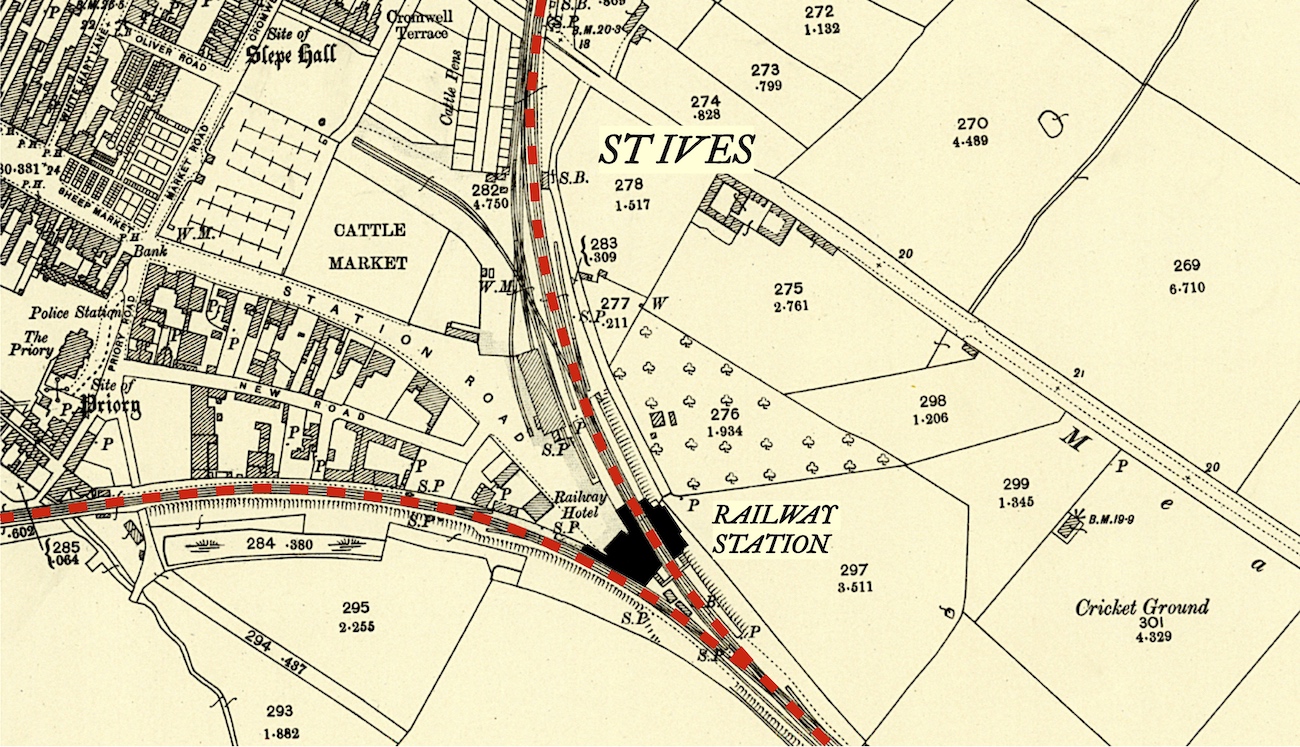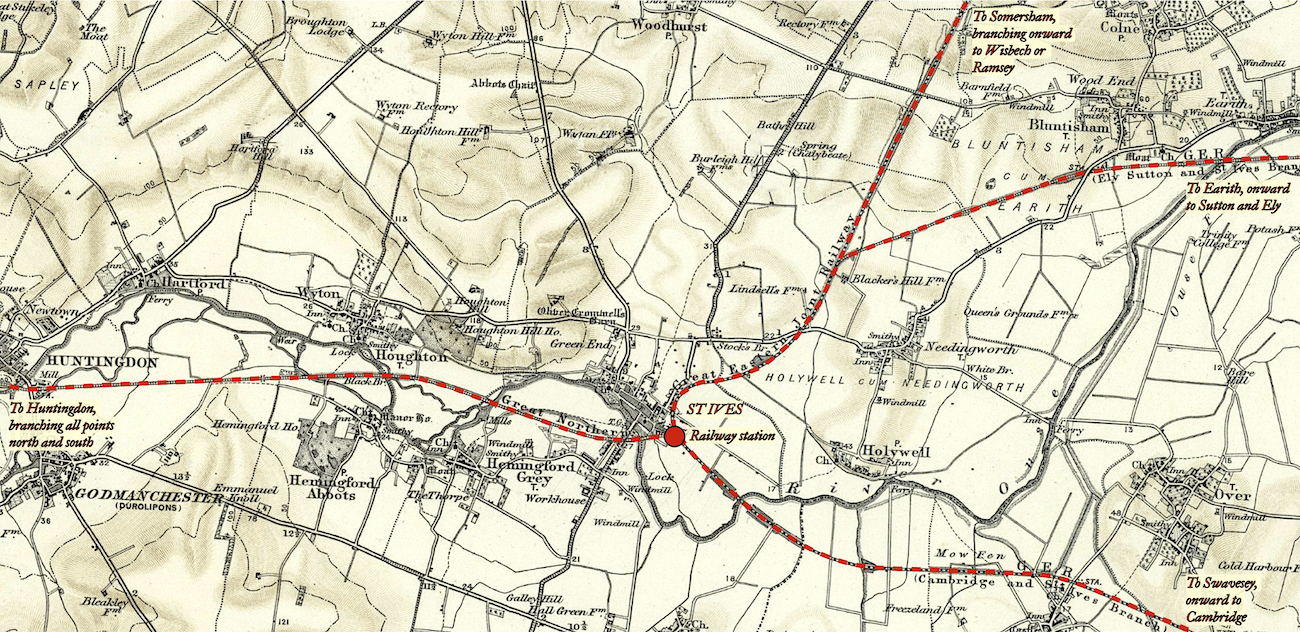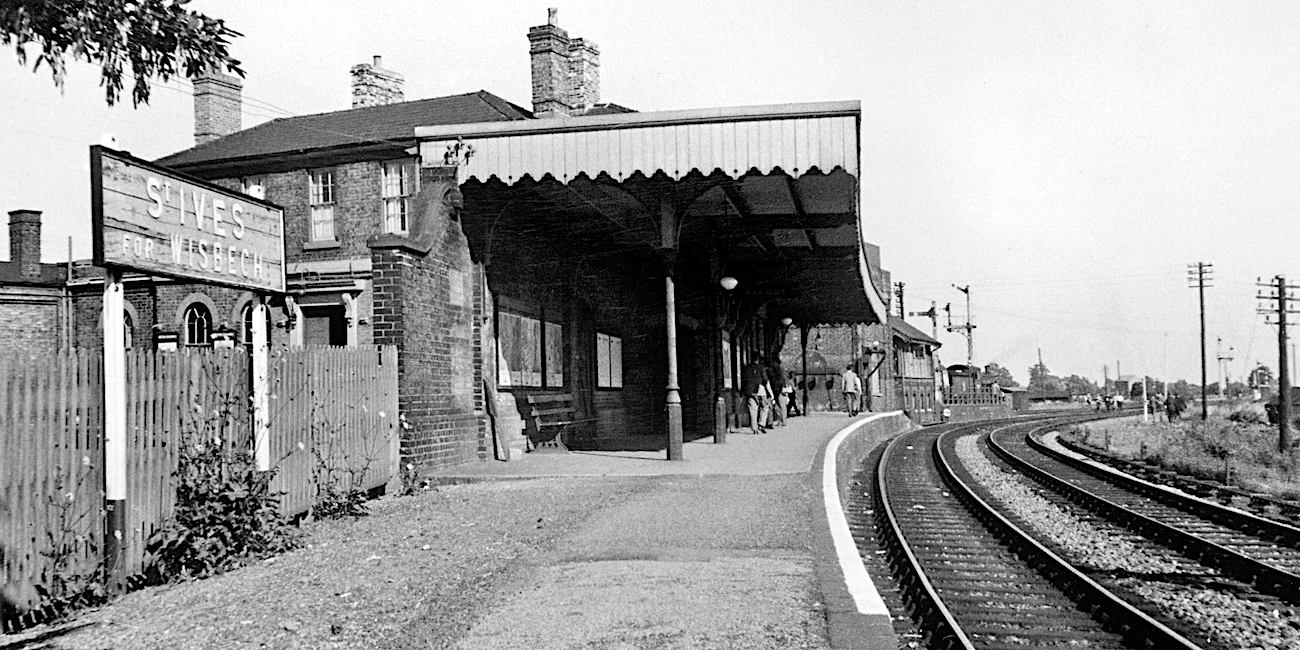Bringing the railway to St Ives
Today's train lines are very much run by Government. In the mid-1800s local businessmen took the risk to build a railway line to their town. It was no different for St Ives. Read on to learn how our town was almost bypassed, the local hero who saved our railway and the scandal that arose.
The first railways
Rail guided transport existed from the 1560s to carry freight such as coal. Motive power was generally provided by horses. In 1807 the first railed horse-drawn passenger-carrying public transport opened.
It was 1802 when the first steam locomotive ran on rails. In 1825 George Stephenson's engine was the first locomotive-hauled public railway in the world.
With the construction of many more lines, the 1840s were boom years. At the start of the decade railway lines in England were few and scattered. Within ten years an almost complete rail network existed. The majority of towns and villages possessed at least one railway connection.
St Ives gets moving
The businessmen in St Ives weren't slow to spot an opportunity.
George Game Day, a solicitor in St Ives, was the instigator. In August 1845 he formed a provisional committee for the St Ives and Wisbech Railway. George published a share offer within a couple of weeks. He set capital at £500,000 and a share offer of 25,000 shares at £20 each. George didn't hang about!
A rail connection to Wisbech was important. It was the nearest port with access to the sea. Barges transported coal and other goods to St Ives. This was unreliable in winter when canals and rivers froze. A rail connection meant cheaper, faster and more reliable transport of goods.
By early September 1845 a deadline was set for share applications. Early October 1845 and news was that the share offer was 'highly popular on the stock exchange and in the county'.
Shares sold out by November 1845. The Eastern Counties Railway bought one-third. 'Persons of unquestionable responsibility' and those interested in the line bought the rest. The investment appeared promising. Anticipating a 4% return and half the profits, this was worth a 9% or 10% return in total.
The next stage was to apply to Parliament for a
Private Act. This gave private individuals or bodies rights. For example, to buy land along the proposed route of the railway. There were several hearings at which rivals or the public raised objections. Rivals objected in a quarter of applications. Many Private Acts failed at their first attempt.
A rival appears
In October 1845 a rival, the Huntingdon, Wisbech and St Ives Union Line published a share offer. It presented a real threat to the ongoing prosperity of St Ives. The rival sought to divert rail traffic away from St Ives to Huntingdon. At best St Ives would connect to the railway network by a branch line. The rival then struck this part of their plan out. The intention was to exclude St Ives from the rail network completely.
Parliament held the second reading of the Wisbech and St Ives Railway Bill. George Game Day petitioned against the rival. He wanted both bids examined at the same time. The rival bidders were not ready.
George claimed the rival bid planned construction 9 feet under the level of the Fens. This made it impossible to build. The promoters of the rival bid declined to meet and paid the costs of St Ives and Wisbech Railway.
When the parties did meet, the rival's agent admitted a 'mere clerical error'. George's claims about their plans were correct. The agent attempted to challenge the plan presented by George Game Day. It transpired the agent used an out of date copy of George's plan. The Parliamentary committee threw out the rival bid.
The positive progress of the application was a cause for celebration in St Ives. Residents met at the Unicorn Inn in March 1846 to recognise the importance of the railway to the town. St Ives also acknowledged the contribution of George Game Day.
Everyone was eager to get started. A little too soon, it seems. In April 1846 workmen cut down trees along the path of the line near New Common Bridge, Wisbech. With no financial compensation agreed between owners and the Company, work stopped.
Construction begins
With the Bill passed in Parliament in August 1846 work immediately started. By September 1846 line was being laid. Building of temporary stations started in February 1847
Building a railway was anything but simple. 230 Commoners had interests in Turf Fen, near Chatteris. Every village along the line wanted a station.
The Company agreed changes as the line was being built. The indefatigable George Game Day represented the Somersham Turnpike Road Commissioner. He got agreement from the Eastern Counties Railway Company to build a 19-foot archway. This replaced the intended railway crossing. It enabled livestock, carts and the public to more easily get to St Ives market.
The new railway made news for reasons other than its construction. Building materials left in the open were too tempting for some. Serious accidents happened. Jobs were created. For the building of Willingham station, wages totalled £1,000 a week (today over £100,000). At every village and town the navvies brought in to work on the railway meant extra business for pubs and inns.
Public recognition for George Game Day
The Eastern Counties Railway Company meeting in August 1846 recognised George Game Day. He was held in high regard. The Company opened a subscription to present him with public testimony, held in September 1846.
A banquet for 200 took place at the Crown Inn yard. The landlord erected a large marquee. Laurel leaves and flowers gathered from every garden in St Ives decorated the yard.
At either end were two six-wheel locomotives. Constructed of laurel leaves, flowers and coloured lamps, one bore George Game Day's name, the other the word 'Union'. A newspaper report commented how fitting this was. There was a perfect union of all parties. 'Whig and Tory, Churchman and Dissenter'. All recognised George's important role in bringing the railway to St Ives.
Male diners sat in the marquee. In the gallery surrounding the courtyard were 80 lady guests. The 'lower classes' were not forgotten. The following day all shops closed at 4.00pm. George Game Day paid for dinner at the Crown Inn yard with ale and tobacco provided. Music, dancing and the peal of the Parish Church bells followed. The event would be long remembered by the inhabitants of St Ives.
In December 1847 the former directors of St Ives and Wisbech Railway recognised again George's contribution. They arrived at his home to present him with an elegant gold cup filled with five hundred gold sovereigns, funded by public subscription. The value of the sovereigns alone would be £52,000 today. The inevitable dinner followed at George's house.
The line opens
The first part of the line opened in April 1847, carrying goods and livestock between March and Wisbech. A passenger excursion was also laid on.
The section from St Ives to Huntingdon opened in August 1847 for passenger carriage. A huge crowd gathered to see the 'Samuel Morten Peto' engine try out the line. The contractor, George Spivey, provided railway labourers with ale and tobacco. St Ives residents got a 'wine spread'.
A Government Inspector and other experts inspected the new line. They paid special attention to the wooden bridges crossing the Great Ouse. George Game Day provided a 'sumptuous luncheon' at his house when they returned.
In March 1848 the line opened from St Ives to Wisbech. About 700 passengers embarked from St Ives. At Somersham hundreds of residents watched the train arrive and 200 boarded. A band played, flags unfurled. Residents dined and planned a ball to celebrate the event.
Businesses closed at Chatteris. A band paraded through the streets and there was a public dinner. A further 1,300 passengers boarded. The stations at Wimblington and March were also crowded. By now the 33 carriages were full. To much disappointment no further passengers boarded.
Passengers arriving at Wisbech dined at the White Lion Hotel. Other hostelries seemed unprepared for the flood of visitors. They stood by the riverside gazing at ocean-going vessels moored at the seaport. The return journey set off at 6.30pm, arriving in St Ives at 8.00pm.
Consequences
Some St Ives businessmen saw the writing on the wall. Within weeks one coach operator advertised the sale by auction of '10 very useful coach horses'. The advert stated the sale was due to the opening of the new railway.
Other businessmen saw opportunities. Henry Hall advertised he would be travelling from Chatteris and St Ives to Smithfield Market every Thursday. He would send drovers to collect cattle for onward transportation to London. The trip, which previously took more than a week, now took a day. Advertisements for the sale of property anywhere near the railway line made a feature of the fact.
Mishap seemed a regular occurrence. In one case an engine cleaner decided to take an engine out by himself. He was fine going forward, but unable to reverse and smashed through one of the gates on the bridge by the St Ives mill. Another engine failed to stop to deliver a sack of coal, careering through another gate.
Some accidents were more serious. James Smith, aged 25yrs, was fatally injured, caught by a chain between an engine on one line pulling carriages on the other.
With so much useful material in the open, pilfering was rife. Jane Hobbs appeared in St Ives Police Court, charged with 'enticing her son, a little child, to steal chips from off the St Ives and Ely railway'.
During the line excavation there were many finds of Roman and other ancient pottery. Strange creatures too... whalebone and ichthyosaurus vertebrae.
Scandal
In 1848 the Wisbech, St Ives and Cambridge Junction Railway Company sold out to the Eastern Counties Railway Company. All private shareholders received £4 a share, a tidy profit on the £2 deposit they had paid for each share.
Eastern Counties Railway had an appalling reputation for timekeeping and safety. In 1845 George Hudson became Chairman. He had developed his home city of York into a major railway junction. Known as 'The Railway King', George was also a Member of Parliament. He controlled a large part of the railway network.
George cut costs and opened more lines in the Eastern Counties Railway network. He employed some sharp practices, paying dividends out of capital rather than revenue. George borrowed money at high interest rates to keep some companies afloat. Many were left in difficulties when revenue fell.
At the Eastern Counties Railway AGM in 1849 George was absent. He left his Vice Chairman David Waddington to face the wrath of shareholders. Waddington blamed George Hudson. A Committee of Investigation on Eastern Counties Railway reported in April 1849. It found there had been reckless extravagance. With far too much spent on stations, expenses and dividends to shareholders, the result was a debt of £500,000 (today £64m).
The AGM mentioned Wisbech and St Ives Railway. It appeared George Hudson and David Waddington were each paid £2,000 (today £200,000) under dubious circumstances. George Hudson paid some of this money back and ultimately became bankrupt. He lost his seat in Parliament and fled abroad to avoid gaol.
More trouble arose in 1856 after the line converted from a double to a single line. A Board of Trade inspection found all was not well. Many new sleepers would soon be required. All the timber bridges were in a considerable state of decay and needed extensive repair. The system to avoid engines from opposite directions meeting along the single line was vague and dangerous. From the report it appeared the change to a single line aimed to minimise expenses.
From 1850 Eastern Counties Railway started selling off surplus land. This land was much more profitable now the railway was nearby. In 1852 there was some discontent about the transport charges for goods along the line. They were much higher than allowed in the Act of Parliament or on other railway lines.
By 1879 railway excursions were a regular feature. Venues were Northampton and Lincoln Races, London, Great Yarmouth, Kings Lynn and Hunstanton. In spite of difficulties over finances, the railway was well and truly popular.
Further reading
1845 Share offer 30 Aug
1845 Share offer for rival 25 Oct
1845 All shares sold 1 Nov
1846 Second Parliamentary reading 28 Feb
1846 Work starts 4 Apr
1846 Meeting of St Ives residents 4 Apr
1846 Royal Assent, proposal for Mr Day's public testimony 22 Aug
1846 George Game Day's banquet 12 Sep
1846 Line being planned 26 Sep
1846 Further work progressed 24 Oct
1846 Purchase of Chatteris & Doddington Turf Fen 28 Nov
1847 St Ives Petty Sessions 6 Mar
1847 Death of a railway worker 20 Mar
1847 First part of line opening 10 Apr
1847 Railway passenger excursion 10 Apr
1847 Somersham archway agreed 22 May
1847 First train into St Ives 7 Aug
1847 The line is inspected 14 Aug
1847 Sale of coach horses 2 Oct
1847 Gates smashed by engines 20 Nov
1847 Presentation to George Game Day 4 Dec
1848 H Hall's advert 5 Feb
1848 St Ives to Wisbech line opened 4 Mar
1849 Committee of Investigation
1850 Surplus land for sale in St Ives
1856 Damning report on line
1893 Timetable








where is the railway now
ReplyDeleteThere are many signs of the railway around St Ives. If you go down London Road away from the town and stop where the bricks in the wall on the left hand side appear much darker, that's where the level crossing was.
Delete